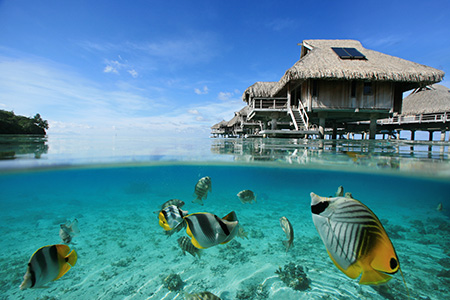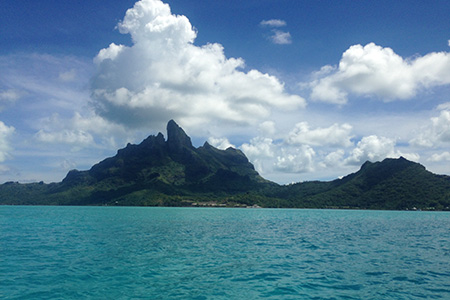A Complete Guide to Vacationing in French Polynesia
by Natasha Wolff | April 16, 2015 5:00 pm
French Polynesia is not just a little tropical getaway where Gauguin painted naked women. It’s actually 118 islands, islets and atolls, dotted across the Pacific Ocean in an area as big as Europe. Its 1,600 square-miles are inhabited by a scant 290,000 inhabitants, one-tenth of them Europeans, in particular, the French. In 1842, France annexed the five Polynesian island groups—including Gambier (famous for supplying the world with black pearls) and the Marquesas (where Gauguin ate pineapples, made art, got leprosy and died). Last week, I explored the Society Islands archipelago—Tahiti, Raiatea Taha’a, Bora Bora and Moorea, among others—swimming in the same waters as mutineer Christian Fletcher of the Bounty and the explorer Captain James Cook and hiking in sight of the volcanic island[1] peak that inspired James Michener’s Bali Ha’i and the musical South Pacific—to find an exotic paradise of my own.
Where to Stay
Aboard a yacht. After flying into Tahiti, we hopped a small plane to Raiatea where we boarded a chartered yacht, the course plotted by Archipels Croiseieres[2]. The yacht was a 46 ft. Catana catamaran that slept eight with two shipshape heads, a full kitchen, dining room, living room and two trampolines at the bow for lounging and sun bathing. No wind that day, we motored through cerulean waters, anchoring to jump off the stern with our snorkels to spy on colorful parrotfish, angels and sergeant majors as they nibbled on coral reefs. We lunched on fresh papayas, ladyfinger bananas, coconut and sashimi before motoring to Taha’a Island to visit the Vallee de la Vanille, a tamanu and vanilla farm. The new harvest of eight-inch vanilla beans was drying in the sun, making the entire place smell like fresh baked cookies. The beans were leathery and thick, nothing like the puny version we have at home. Later that afternoon, we napped on the trampolines, waking in time to spot a pod of dolphins swimming alongside the yacht, welcoming us to their seas.
Hilton Bora Bora Nui Resort and Spa[3]. From Raiatea, we took a puddle-jumper to Bora Bora and ferried by yacht to the five-star Hilton Nui, the only resort on the island’s longest beach. The resort couldn’t be more glorious. No wonder The Bachelor, Amazing Race, Survivor and Keeping Up With the Kardashians have filmed there. I stayed in a 1,000-square-foot mountaintop villa with a breathtaking view. Dinner was at the Iriatai, an open-air restaurant with a white sand floor. While enjoying my grilled mahi-mahi with vanilla sauce, I dug my toes in the sand and stared at the dazzling display of stars, including the Southern Cross, overhead. To get around the resort and up the hill to the mountaintop spa and our villas, we were chauffeured in golf carts. Along the ride, sipping rum cocktails and wearing Polynesian linen wraps called pareos, I felt decadent and pampered, a bit like Kim K. herself.
Hilton Moorea Lagoon Resort and Spa[4]. Moorea isn’t as famous as Bora Bora, but I don’t see why not. The heart-shaped “island of love” is only 25 minutes by ferry from Tahiti, making it easier to get to than Bora Bora or Taha’a. My room at the Lagoon Resort was a coveted 700-square-foot thatched over-water villa. A glass-bottom panel by the couch revealed fish swimming lazily beneath me.

A villa on Bora Bora
What To Do
Lunch on Motu Tapu. Motu means island and Tapu means forbidden. The tiny islet—available to Bora Bora Nui guests only—is 20 minutes by ferry from the hotel. It was once the personal, exclusive playground of Polynesian Queen Teriimaevarua (hence, “forbidden”) in the late 1800s. Today, it is uninhabited and unspoiled, a square half-mile of white sand beach, indigenous conifers and palm trees at the center of a magnificent coral reef. My friends and I spent the whole morning in this idyllic spot. Except for a small team of chefs and servers who organized our picnic, we were the only people there. At a table set at the water’s edge we ate grilled lobster, shrimp, shark steak and tuna sashimi as schools of small fish tickled our feet.
Swim with sharks and rays. We took a boat tour[5] of a deeper part of the reef. Our guide Leo threw some bait into the water and dozens of string rays and about forty reef sharks appeared. The rays immediately swum right up to us, begging for food like city park squirrels. They were slippery and enormous, three-feet across their gray backs, with four-foot tails featuring intimidating stingers.
Get inked. The tribal sleeve tattoos you see on hipsters in Brooklyn? The original designs were invented by French Polynesian warriors centuries before Williamsburg was a thing. Nearly every Society Islander—young and old, male and female—is inked with a black and gray fine lined tatau so beautiful, it makes virgin-skinned tourists seriously consider getting one. In Papeete, the capital city of Tahiti, you can find shirtless tattoo artists in stalls at the market, their own markings advertising their skills. Papeete’s Mana’o Tattoo[6] studio boasts several international award-winning artists. If you’re a traditionalist/masochist, you can request the painstaking, primitive method of puncturing the skin thousands of times with a sharp whalebone needle and injecting ink into the wounds. Otherwise, the faster and less painful option is using a machine. If tribal designs aren’t your thing, a sea turtle tattoo symbolizes long life, and a stingray is the symbol of the good life. A small one costs around 40,000 Polynesian francs ($400). For sleeve or expansive back art, that number will go way, way up.
What to Eat
Poisson Cru, the signature dish of Tahiti, is a salad of sushi-grade raw ahi or yellowfin tuna “cooked” in lime juice, plus cucumbers, tomatoes, onions and coconut milk to create a ceviche-like dish full of complex flavors. At the Moorea’s Rotui Bar and Grill, they serve poisson cru cutely in a coconut shell. Slight variations (sometimes green pepper, sometimes scallions) kept it interesting, which is important, since you will be served this dish at nearly every meal.
Crepes de Bretagne. French Polynesia is, obviously, a French territory. The locals speak French and use francs. Frenchman can come to work and live in the region without a visa. Therefore, the islands are crawling with French chefs, in particular, those from Brittany, the birthplace of the crepe. We went to Moorea Lagoon’s open-air Toatea creperie, located at the hub of spokes of overwater villas piers. For my main course, I ordered the Captain Cook, a crispy yet doughy envelope stuffed with potato, onion, smoked bacon, gruyere and white wine, a decadent change of pace after so much grilled and raw fish. For dessert, I had the Suzette, bien sur. The chef came to our table and poured the Grand Marnier a flambé over my crepe, a delight for the eyes.

Bora Bora
What To Buy
Pearls. Ubiquitous Robert Wan[7] stores are in every hotel, resort or shopping center, selling shimmering black pearls[8] harvested from black-lipped oyster farms in the Tuamoto and Gambier archipelagoes about 600 miles east of Tahiti. The necklaces, earrings and rings of black and gray pearls with seductive green, pink, blue and gold undertones were stunning. I wanted to buy everything, but managed to refrain. The Tahitians use baroque or misshapen pearls inventively, stringing them on long cords to use like hippie era beaded curtains.
Tamanu Oil. Most people associate Tahiti with monoi oil made from coconuts, but I have to recommend the anti-inflammatory, antioxidant-packed tamanu oil, produced from the nut of the tamanu tree. Tahitians use it on rashes, cuts, infections, bites and even acne. It’s the topical, tropical secret, they say, of why Polynesian women have no wrinkles.
The Details
Air Tahiti Nui[9] flies from Los Angeles to Tahiti six days a week, several flights per day. First class is quite comfortable, which makes the eight-hour flight a breeze. Air Tahiti also proves regularly scheduled flights between islands.
Dream Yacht Charter[10]. If you’d rather spend your vacation sailing from island to island versus flying, book a catamaran and crew, including food and taxes and a few extras, for around $2,500 per person per week.
Bora Bora Nui Resort & Spa[11]. Room rates depend on travel dates and villa type. For a garden villa, it’s $600 per night; a mountain villa, $800; over-water villa, $1,000 to $1,500. The Presidential two-story 3,200 square-foot over-water villa (where Kim Kardashian was pushed off the lanai and lost a $75,000 earring), is $5,000 per night. Meals not included.
Moorea Lagoon Resort and Spa[12]. Less expensive rates can be had during the rainy season. At peak, prices are: garden villas, $570 per night; pool villas, $650 to $720; over-water villas, $900 to $1,000. Meals not included.
- island: http://dujour.com/lifestyle/isla-simca-private-jungle-island-panama/
- Archipels Croiseieres: http://www.dreamyachtcharter.com/
- Hilton Bora Bora Nui Resort and Spa: http://www3.hilton.com/en/hotels/french-polynesia/hilton-bora-bora-nui-resort-and-spa-PPTBNHI/index.html?WT.mc_id=zELWAGN0AP1WW2PSH3Search4DGGeneric&WT.srch=1&utm_source=AdWords&utm_medium=ppc&utm_campaign=paidsearch
- Hilton Moorea Lagoon Resort and Spa: http://www3.hilton.com/en/hotels/french-polynesia/hilton-moorea-lagoon-resort-and-spa-PPTMLHI/index.html?WT.mc_id=zMWWAAA0EA1WW2PSH3Search4DGGeneric7GW842004&WT.srch=1
- boat tour: https://www.facebook.com/raanuitourssafarilagoon
- Mana’o Tattoo: http://manaotattoo.com/#/home/4522676446
- Robert Wan: http://www.robertwan.com/en
- black pearls: http://dujour.com/lifestyle/french-polynesia-black-pearl-diving/
- Air Tahiti Nui: https://www.airtahitinui.com/us-en?gclid=CN-X6IaW4sQCFdAF7AodKwYA-w
- Dream Yacht Charter: http://www.dreamyachtcharter.com/english/destinations/pacific/tahiti/
- Bora Bora Nui Resort & Spa: http://www3.hilton.com/en/hotels/french-polynesia/hilton-bora-bora-nui-resort-and-spa-PPTBNHI/index.html
- Moorea Lagoon Resort and Spa: http://www3.hilton.com/en/hotels/french-polynesia/hilton-bora-bora-nui-resort-and-spa-PPTBNHI/index.html
Source URL: https://dujour.com/life/french-polynesia-travel-guide-society-islands-food-hotels/